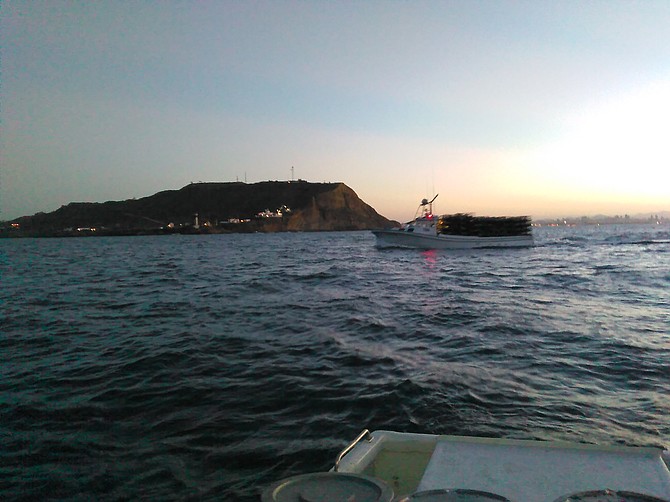 Facebook
Facebook
 X
X
 Instagram
Instagram
 TikTok
TikTok
 Youtube
Youtube

The first Wednesday in October (October 7 this year) marks the opening day of the commercial lobster season in California. In the weeks and months prior, permit holders are busy building traps, mending lines, and getting their boats ship-shape.
As the season nears, activity builds to a crescendo, culminating on the Tuesday before the opener, Bait Day. This is the first day lobster traps may legally hold bait. A week prior to the opener, traps may be set but without bait and the doors must be wired open. According to the Fish and Wildlife website, the average permit-holder will work between 300 and 700 traps. Depending on the size of the boat, it takes many trips to set all the traps in place.
On bait day, every trap is hauled, filled with bait, and set. It makes for a long, hard day for captain and crew usually lasting between 12 to 14 hours. This year, off of San Diego, the ocean conditions were calm with a 1–2 foot south swell and westerly winds of 8 to 10 knots. Air temperatures were in the 70s and it was sunny. A pleasant day.
According to the Department of Fish and Wildlife website, there are currently 181 lobster operator permits in the state. 2014 saw 52 lobster permit holders make landings in San Diego County. Total landings for 2014 for the San Diego area were 272,683 pounds of lobster. In contrast, the Santa Barbara area saw 399,259 pounds landed.
State biologists are thinking that the warmer ocean temps we are experiencing statewide will increase this season’s catch because the lobsters will be more active. At least one local fisherman has seen an increase of nearly 80 pounds over last year’s first pull.
Last week, a sport diver in Long Beach reported catching a green spiny lobster, Panulirus gracilis, which are usually found in the warmer waters of southern Baja and southward to Peru. One was also taken last year in San Diego.


The first Wednesday in October (October 7 this year) marks the opening day of the commercial lobster season in California. In the weeks and months prior, permit holders are busy building traps, mending lines, and getting their boats ship-shape.
As the season nears, activity builds to a crescendo, culminating on the Tuesday before the opener, Bait Day. This is the first day lobster traps may legally hold bait. A week prior to the opener, traps may be set but without bait and the doors must be wired open. According to the Fish and Wildlife website, the average permit-holder will work between 300 and 700 traps. Depending on the size of the boat, it takes many trips to set all the traps in place.
On bait day, every trap is hauled, filled with bait, and set. It makes for a long, hard day for captain and crew usually lasting between 12 to 14 hours. This year, off of San Diego, the ocean conditions were calm with a 1–2 foot south swell and westerly winds of 8 to 10 knots. Air temperatures were in the 70s and it was sunny. A pleasant day.
According to the Department of Fish and Wildlife website, there are currently 181 lobster operator permits in the state. 2014 saw 52 lobster permit holders make landings in San Diego County. Total landings for 2014 for the San Diego area were 272,683 pounds of lobster. In contrast, the Santa Barbara area saw 399,259 pounds landed.
State biologists are thinking that the warmer ocean temps we are experiencing statewide will increase this season’s catch because the lobsters will be more active. At least one local fisherman has seen an increase of nearly 80 pounds over last year’s first pull.
Last week, a sport diver in Long Beach reported catching a green spiny lobster, Panulirus gracilis, which are usually found in the warmer waters of southern Baja and southward to Peru. One was also taken last year in San Diego.
Comments